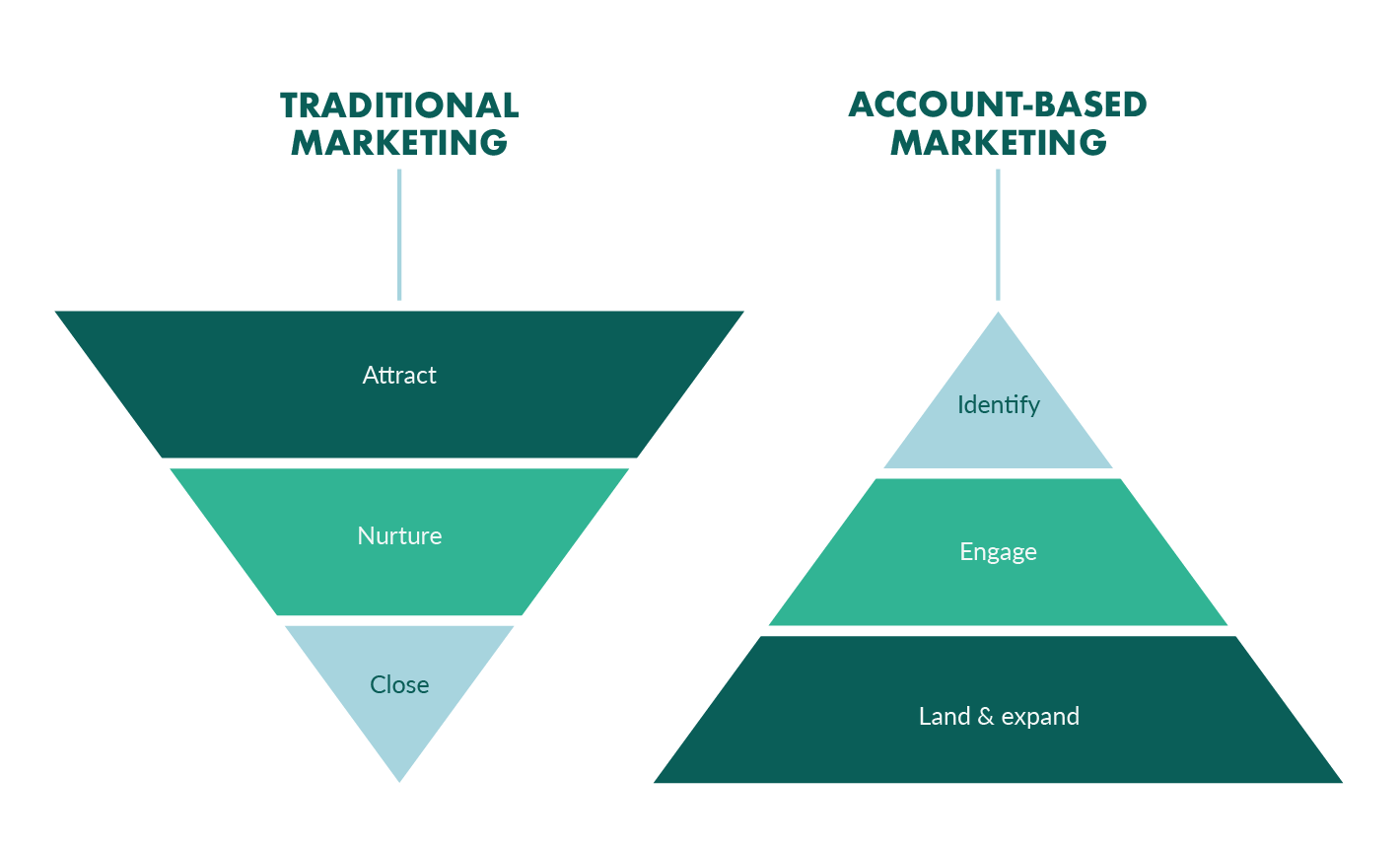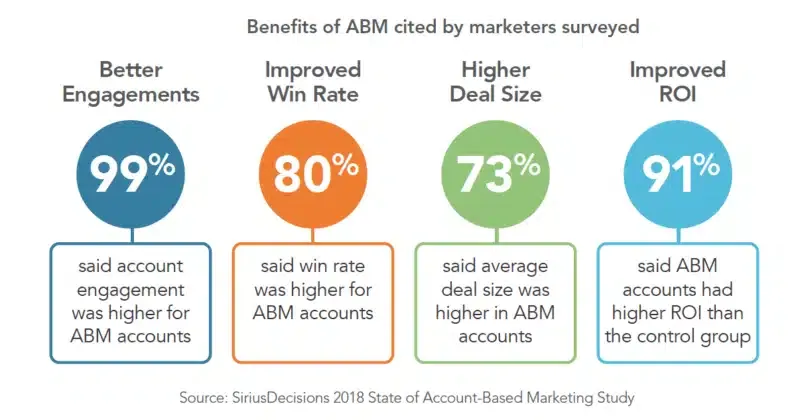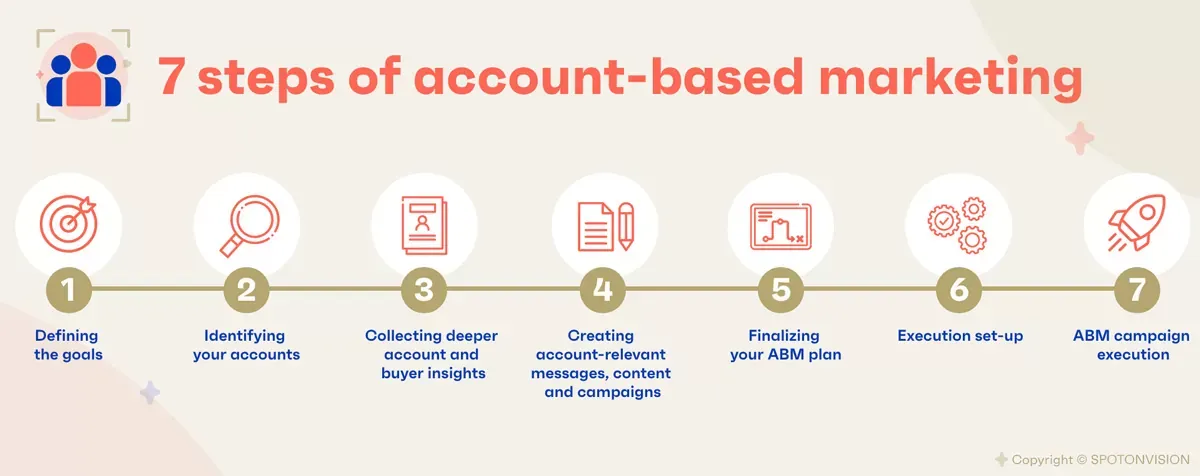Frustrated with poor conversion rates from high-funnel tactics? Exhausted chasing an ever-growing list of "target accounts"? It's time to rethink B2B marketing.
The future is 1:1, not 1:many. Recent Forrester data reveals that account-based marketing generates 2.6x more sales opportunities compared to traditional methods.
Account Based Marketing delivers results by focusing sales and marketing on high-value accounts versus spreading efforts thin across a broad target base.
But is your team truly set up for Account Based Marketing success? Do you have the data, workflows, content, and strategy required? Unlocking ABM's potential takes more than renaming an account list.
This guide will walk through transforming your B2B marketing strategy around targeted, personalized account experiences. Continue reading to know more about Account based marketing strategies.
What is ABM?
ABM, or Account-Based Marketing, is a strategic marketing approach where businesses target specific high-value accounts with personalized campaigns, rather than casting a wide net.
Account Based Marketing involves close collaboration between sales and marketing teams to identify key accounts, create tailored content, and engage with decision-makers.
Account Based Marketing aims to build strong, long-lasting relationships with these accounts, ultimately driving revenue growth and customer retention.
It's highly effective for B2B companies seeking to maximize ROI by focusing on the most promising prospects, and aligning marketing efforts.

Why is ABM important?
Account-Based Marketing (ABM) has emerged as a crucial strategy in the world of B2B marketing for several compelling reasons. At its core, ABM is about treating each customer like a unique market of one.
Here's why ABM is important:
Precision Targeting
ABM allows you to focus your resources on high-value accounts that are most likely to convert. Instead of casting a wide net and hoping for the best, you're essentially using a laser-focused approach. This precision targeting maximizes the efficiency of your marketing efforts.
Personalization
ABM lets you tailor your messaging and content to individual accounts, addressing their specific pain points and needs. This personal touch increases engagement and builds stronger relationships.

Alignment of Sales and Marketing
ABM fosters closer collaboration between sales and marketing teams. When both teams work together to identify, target, and nurture key accounts, it leads to more effective communication and a shared goal of revenue growth.
Enhanced ROI
By concentrating your efforts on high-potential accounts, you're more likely to see a higher return on investment. The resources you allocate are directly proportional to the potential rewards, making ABM a cost-effective approach.
Customer Retention
ABM isn't just about acquiring new customers; it's also about retaining and growing existing ones. By continually engaging with and meeting the unique needs of your key accounts, you foster loyalty and reduce churn.
Brand Reputation
When you provide personalized, value-driven experiences, your brand's reputation soars. Happy, engaged customers are more likely to become advocates, spreading positive word-of-mouth and attracting more business.
Scalability
ABM isn't just for large enterprises. It can be scaled to fit the needs and resources of businesses of all sizes. Whether you're targeting a handful of accounts or hundreds, ABM is adaptable.
Implement a Successful Account Based Marketing Strategy
Given below are steps to implement a successful Account Based Marketing strategy:

Conducting thorough account research and analysis
The foundation of a strong Account Based Marketing strategy lies in conducting thorough account research and analysis.
You need to gather detailed information about your target accounts, such as their pain points, goals, and challenges. Think of it as detective work!
By understanding your target accounts inside out, you'll be able to create highly targeted campaigns that hit the mark every time.
Creating personalized content
Once you have all the juicy details about your target accounts, it's time to put that information to good use by creating personalized messaging and content for each account.
Craft compelling emails, design customized landing pages, and create specific offers that speak directly to the needs of each account. The more tailored your content is, the better chance you have of catching their attention and driving engagement.
Selecting the right channels for reaching targeted accounts
When it comes to reaching your target accounts, you need to think about the channels that will be most effective. Will it be email, social media, or maybe even good old-fashioned snail mail?
Each account might respond differently to different channels, so it's important to do some testing and see which ones yield the best results. Remember, you want to get the right message in front of the right people through the right channels.
Suggested Reading:
How to Effectively Utilize Chatbots for Improved ABM Results
Leveraging Data and Technology for Effective ABM
Data analytics is a powerful tool for Account Based Marketing. Read on to see how to leverage data and technology for effective ABM.
Utilizing data analytics to identify ideal customer profiles
By analyzing data from various sources, you can identify your ideal customer profiles - the types of customers who are most likely to convert and drive revenue for your business. This helps in creating personalized targeted campaigns and messaging that are more likely to resonate with your audience.
So, make sure you're putting your data to work for you by utilizing data analytics and identifying your ideal customer profiles.
The role of marketing automation in ABM
Marketing automation is another key component of a successful Account Based Marketing strategy. Market automation saves you time and effort and helps you stay on top of your campaigns.
But remember, even with automation, it's important to maintain that personal touch and human connection with your audience.
Integrating CRM systems for seamless ABM execution
This is where integrating your CRM systems comes into play. By integrating your CRM systems with your Account Based Marketing strategy, you can create an efficient workflow that delivers personalized content and messaging to your targeted accounts.
This helps you to create a seamless and coordinated Account Based Marketing execution that maximizes your results.
Measuring and Optimizing Your ABM Success
Now that we know how to utilize data and technology to make our Account Based Marketing strategy more effective, let's talk about how to measure and optimize our ABM success.
Here is how you should measure and optimize your Account Based Marketing success:
Key metrics to track in ABM
Measuring the success of your Account Based Marketing strategy is crucial to optimize it for even better results. Some of the key metrics you should track include engagement rates, conversion rates, pipeline velocity, and revenue impact.
Using A/B testing to optimize campaign performance
A/B testing is the process of testing two variations of a campaign to determine which one performs better. By testing different versions of your content and messaging, you can optimize your campaign performance and improve your results.
Iterating and adapting Account Based Marketing strategies based on results
An effective Account Based Marketing strategy requires constant iteration and adaptation based on results. Analyzing your data and key metrics, and experimenting with different approaches should be an ongoing process.
Case Studies: Real-World Examples of Successful ABM
Account Based Marketing can be applied to any industry, and there are plenty of successful campaigns to choose from. Let's take a look at some of the most effective ABM campaigns:
Technology Industry
Cloudera, a software company, implemented ABM to target enterprise-level accounts. By creating personalized content and leveraging targeted account-based advertising, they saw a 125% increase in average deal value and a 76% reduction in customer acquisition costs.
Financial Services Industry
Lincoln Financial, a financial services company, utilized ABM to improve its retirement plan offerings. By using personalized outreach and targeted content, they increased their prospect response rate by 900% and achieved an ROI of 1300%.
Manufacturing Industry
3M, a manufacturing company, used ABM to engage with their high-priority accounts. By creating targeted content and leveraging analytics to deliver personalized campaigns, they achieved a 200% increase in engagement and saw a 40% reduction in the sales cycle.
Evaluating the Strategies Used in Case Study
All of these campaigns incorporated similar tactics to achieve success:
- Personalization
Each campaign used personalized messaging and content to reach their target accounts. By customizing their approach to each account, they were able to increase engagement and build meaningful relationships.
- Alignment between sales and marketing
Successful ABM requires collaboration between sales and marketing teams. By aligning their goals, messages, and metrics, these companies were able to achieve a seamless customer experience and boost conversions.
- Data Analysis
These companies relied heavily on data analysis to optimize their campaigns continually. By tracking their progress and analyzing customer behavior, they were able to make informed decisions and adjust their approach in real time.
The Future of ABM
As with any marketing strategy, Account Based Marketing is continually evolving.
AI and automation
Artificial intelligence and automation are revolutionizing ABM. By automating tasks and leveraging AI-powered insights, you can enhance personalization, streamline workflows, and achieve greater scale and efficiency.
Integrated ABM
ABM is becoming more integrated with other digital marketing tactics. By combining ABM with demand generation, social media marketing, and other tactics, you can create a cohesive, omnichannel customer experience.
Advanced analytics
As data analysis becomes more advanced, you can expect to see even more sophisticated insights and metrics for measuring ABM success.
Conclusion
The verdict is clear – an account-based approach aligns sales and marketing around what matters most: strategic target accounts. By orchestrating tailored outreach, Account Based Marketing converts contacts into customers.
Now you're equipped with an actionable blueprint to shift from broad-based efforts to targeted account strategies based on the proven Account Based Marketing methodology.
While the change takes commitment, the results make it worthwhile. According to ITSMA, ABM delivers close rates of over 50%, while traditional marketing averages less than 10%.
ABM has more high-quality opportunities, improved win rates, accelerated deals, increased retention and lifetime value.
Companies using ABM experience 208% greater ROI over traditional methods according to TOPO Research.
ABM's highly personalized experiences achieve a new level of marketing performance. Don't wait - embrace ABM now to drive growth and align sales and marketing efforts for maximum impact. The time for account-based strategies is now!
It's time to get on board!
Frequently Asked Questions (FAQs)
What is the role of account-based marketing?
Account-Based Marketing (ABM) focuses on personalized marketing efforts for specific target accounts. Its role is to identify, engage, and nurture high-value accounts through customized content and strategies to drive conversion and revenue growth.
What is B2B account-based marketing?
B2B Account-Based Marketing (ABM) is a strategic marketing approach where businesses target and tailor their efforts to specific high-value accounts. It involves personalized campaigns, content, and interactions to build strong relationships and drive sales in the B2B sector.
How can I measure the ROI of my ABM campaigns?
Measuring ABM ROI involves tracking metrics like pipeline value, deal conversion rates, and customer retention to assess the impact of your strategy.
What tools and technologies can enhance ABM efforts?
ABM software, CRM systems, marketing automation, and data analytics tools can all enhance your ABM efforts.
How do I identify the right accounts for my ABM strategy?
Identifying ideal accounts involves analyzing data, considering your business goals, and aligning with sales teams to pinpoint high-value prospects.



